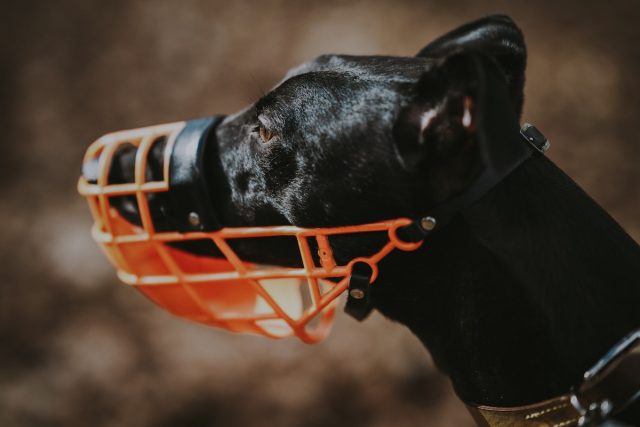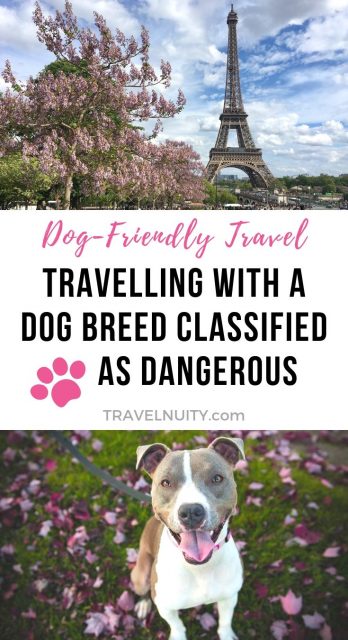While it’s sad to tag a dog as “dangerous” simply due to its breed, unfortunately there are numerous dog laws around the world that classify certain dogs breeds as dangerous, or apply restrictions for certain dog breeds. While you may consider your own dog to not be “dangerous”, it may be affected by these rules and complicate travelling with your dog.
Before travelling with your dog, you should find out whether there are restrictions for your dog based on its breed, in any of the countries or regions that you intend to visit. Depending on your dog’s breed, restrictions may range from a ban on entering certain countries to not being allowed on public transport or being required to wear a muzzle.

Dog Breeds Banned by Countries
Many countries around the world ban the import of certain breeds of dogs classified as dangerous, or hybrids with wolfs. These rules vary from country to country, in particular the dog breeds affected and whether only pure breeds or mixed breeds are affected.
For instance, in my home country of Australia, it is not permitted to import these dog breeds:
- Dogo Argentino
- Fila Brasileiro
- Japanese Tosa
- American pit bull terrier or pit bull terrier
- Perro de Presa Canario or Presa Canario
- Czechoslovakian wolfdog or Czechoslovakian Vlcak
- Saarloos wolfdog or Saarloos wolfhound
- Lupo Italiano or Italian wolfdog
- Kunming wolfdog or Kunming dog
If you have a dog potentially affected by these rules, always check in advance before making plans to travel to any country. The website PetTravel.com has a section on banned breeds for each country covered.
Dog Breeds Classified as Dangerous

Additional dog breeds may not be outright banned from entering a country, but may be classified as dangerous and have certain restrictions and requirements for ownership. This may include:
- Requiring a special license
- Requiring you to take a training course
- Requiring the use of a short leash and muzzle in public
- Being banned from public spaces and parks
- Being banned from public transport
- Being banned from air travel
Note that while I’ve often seen restrictions on dogs staying at certain hotels based on their size, I haven’t usually seen any rules restricting certain dog breeds, but this is likely to also be the case, particularly when pets are only allowed “on request”.
There may additionally be rules that apply just in a particular state or city, including in some parts of the USA and Canada, where the term “breed-specific legislation” (or BSL) is used.
Previously, a handy resource to check the rules for different countries was Petolog, but this website is no longer online. In any case, it’s always best to try and track down the laws published by the relevant government departments, as rules can change.
Dangerous Dog Breed Laws in France

One of the most popular countries for people to visit with their dogs but that has strict rules about dangerous dog breeds is France.
In France, there are two classifications for dogs (in French only). Category 1 dogs include:
- Any dog of the type known as American Staffordshire Terrier (formerly Staffordshire Terrier), also called “pit-bulls”, without a pedigree (including cross-breeds)
- Any Mastiff-type dogs, also called “boerbulls”, without a pedigree (including cross-breeds)
- Any Tosa-type dogs without a pedigree (including cross-breeds)
These dog breeds are not allowed to be imported into the country. Presumably this also includes on a temporary basis, while travelling.
Note that the Staffordshire Bull Terrier is not grouped with the American Staffordshire Terrier and is not classified as dangerous. Make sure you have your papers showing your dog is not one of these breeds (or crossed with these breeds) if any confusion is likely to take place.
On the other hand, Category 2 dogs are able to be imported into France but restrictions apply. The following breeds are Category 2 dogs:
- American Staffordshire Terriers (formerly Staffordshire Terriers) with a pedigree
- Tosas with a pedigree
- Rottweilers with a pedigree, plus Rottweiler-type dogs without a pedigree
There are a number of rules to follow with these dogs, including:
- The owner must be over 18 and not have a criminal record
- The owner must attend a training course
- The owner must have civil liability insurance
- Must have a behavioural evaluation
- Must be walked on a lead and with a muzzle (including on public transport)
- According to the Air France pet policy, can only fly as cargo
This is not an exhaustive list. For further information in English see this page and this page.
While these rules for Category 2 dogs certainly apply if you are moving to France with your dog, it is not clear what rules apply if you are travelling through the country only temporarily with a dog affected by this legislation. (And if you are moving to France, I would expect that you would be allowed a certain period of time before you have to meet all the requirements.)
The strongest safeguard would be to not take a dog belonging to any of these breeds to France. A more workable solution might be to take precautions, including carrying your pedigree papers, always using a leash and muzzle and possibly not taking your dog on public transport.
Dangerous Dog Breed Laws in Spain

Spain also has rules relating to dangerous dog breeds, but they are different to the rules in France. If you are travelling to Spain with your dog, be aware that the following breeds are classified as dangerous (according to the information provided by the UK Caravan Club):
- American Staffordshire Terrier
- Pit Bull Terrier
- Staffordshire Bull Terrier
- Rottweiler
- Dogo Argentino
- Fila Brasiliero
- Tosa Inu
- Akita Inu
- Doberman Pinscher
None of these dog breeds are banned from entering the country, but instead you are required to register your dog and get a license within three months of arriving in Spain. This means that if you are visiting temporarily for less than three months, you do not need to register your dog.
Some personal stories about people’s experience in Spain have been shared in this forum.
The New Ban on XL Bullys in the UK
The UK isn’t immune from rules banning particular breeds of dogs. In addition to a longstanding ban on owning Pit Bull terriers, Japanese Tosas, Dogo Argentinos and Fila Brasileiros, in 2024 a new breed will be added to the list: the XL Bully.
Part of the problem of adding the XL Bully to the list of banned breeds is that it isn’t an official dog breed. It’s simply the largest variant of the American bully breed, bred from dogs including the already-banned American pitbull terrier. To see if your dog may be affected, see this official definition.
From 31 December 2023, it will be against the law to sell or breed such a dog, or to have it in public without a leash or muzzle. From 1 February 2024, it will be an offence to simply own such a dog in England or Wales, with a Certificate of Exemption – only issued if your dog is neutered, microchipped and you have third party public liability insurance.
It is currently recommended to take a precautionary approach if your dog may be classified as an XL Bully. If you have a large bully dog and intend to travel to the UK, I recommend reconsidering if your dog may be considered one.
If you are moving to the UK with your dog, apply for a Certificate of Exemption as soon as possible – if you are asked to produce one, you have five days in which to produce it.
Tips for Travelling with a Dangerous Dog Breed
If you plan to travel abroad with a dog bread that is potentially classified as dangerous, I recommend taking these precautions:
- Try to find out the laws for the countries (or states) that you will be visiting (although I know from personal experience that it can be impossible to find information published by the actual government, but often other websites will contain some information, or ask in an online forum)
- Try to follow the laws stipulated by the country
- If in doubt, keep your dog on a short leash and wearing a muzzle in public
- Before taking public transport, try to find out whether your dog breed is allowed onboard
- Be aware that additional restrictions or requirements may apply to your dog when flying, similar to short-nosed dog breeds
If you have any doubt about the safety of your dog, particularly if there is a chance it may be outright banned by the country you intend to visit, or if it looks similar to those breeds and you do not have papers, the safest option is to unfortunately leave your dog behind.
You May Also Like
- Traveling in France with a Dog
- Travelling in Spain with a Dog
- Do You Need a Dog Muzzle when Travelling in Europe?
About the Author

Shandos Cleaver is the founder of Travelnuity: Dog-Friendly Travel. She has travelled extensively with her Miniature Dachshund, Schnitzel, including to 33 countries across Europe, every state and territory of Australia except Tasmania, and 10 of the United States. She’s passionate about providing inspiration and information to others wanting to travel with their dogs, whether close to home or internationally.
Pin this to your Pinterest board!


We are travelling through France to Spain with our boxer x mastiff would this be allowed
This is a grey area, as mastiff cross-breeds are not allowed to be imported into France. I’ve heard of cases where such dogs are taken through France, travelling to another country, at least crossing borders by road. Additionally, if you are planning to travel with your car via the Eurotunnel Le Shuttle, there is no mention on their website about banned breeds.